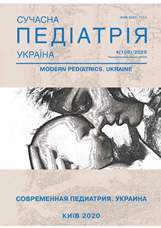Debut and course rare of juvenile dermatomyositis. Part I: clinical case
Keywords:
juvenile dermatomyositis, juvenile amyopathic dermatomyositis, atypical course, ulcerative necrotic glossitis, anasarca, psoriasis, treatmentAbstract
Describes the onset and course of a rare case of juvenile dermatomyositis. Its peculiar сlinical was the beginning of the disease with a predominance of signs of severe intoxication, ulcerative-necrotic damage of the tongue and anasarca. Typical cutaneous clinical manifestations of the disease were delayed by one month. Laboratory studies revealed an increase in the level of the acute inflammatory markers and titers of antinuclear antibodies, and among the enzymes specific for the myopathic syndrome, only increased alanine aminotransferase activity was positive. The electromyogram did not record any violations. Two years later, comorbidity of the disease with psoriasis vulgaris was noted. Long-term (seven-year) observation revealed chronic amyopathic course of the disease. It has been shown that the use of standard treatment with methylprednisolone, methotrexate and plaquenil in this case is not effective enough.
The second part of the article will be provide a review of the literature on other atypical variants of the onset and course of juvenile dermatomyositis and comparative clinical analysis of this clinical case with other similar observations.
The research was carried out in accordance with the principles of the Helsinki Declaration. The study protocol was approved by the Local Ethics Committee of participating institution. The informed consent of the patient was obtained for conducting the studies.
References
Barth Z, Witczak BN, Schwartz T et al. (2016). In juvenile dermatomyositis, heart rate variability is reduced, and associated with both cardiac dysfunction and markers of inflammation: a cross-sectional study median 13.5 years after symptom onset. Rheumatology. 55(3): 535–543. https://doi.org/10.1093/rheumatology/kev376; PMid:26500284
Bowerman K, Pearson D, Okawa J et al. (2020). Malignancy in Dermatomyositis: A Retrospective Study of 201 Patients Seen at the University of Pennsylvania. J American Academy Dermatology. https://doi.org/10.1016/j.jaad.2020.02.061; PMid:32135206
Dobloug GC, Svensson J, Lundberg IE et al. (2018). Mortality in idiopathic inflammatory myopathy: results from a Swedish nationwide population-based cohort study. Annals of the Rheumatic Diseases. 77: 40–47. https://doi.org/10.1136/annrheumdis-2017-211402; PMid:28814428
Enders FB, Bader-Meunier B, Baildam E et al. (2017). Consensusbased recommendations for the management of juvenile dermatomyositis. Annals Rheumatic Diseases. 76: 329-340. https://ard.bmj.com/content/76/2/329. https://doi.org/10.1136/annrheumdis-2016-209247; PMid:27515057 PMCid:PMC5284351
Gitiaux C, Antonio M, Aouizerate J et al. (2016). Vasculopathyrelated clinical and pathological features are associated with severe juvenile dermatomyositis. Rheumatology. 55(3): 470–479. https://doi.org/10.1093/rheumatology/kev359. https://doi.org/10.1093/rheumatology/kev359; PMid:26424834
Huber AM, Feldman BM. (2005). Long-term outcomes in juvenile dermatomyositis: How did we get here and where are we going?. Curr Rheumatol Rep. 7: 441–446. https://doi.org/10.1007/s11926-005-0048-1; PMid:16303103
Kim S, Kahn P, Robinson AB et al. (2017). Childhood Arthritis and Rheumatology Research Alliance consensus clinical treatment plans for juvenile dermatomyositis with skin predominant disease. Pediatr Rheumatol. 15(1). https://doi.org/10.1186/s12969-016-0134-0; PMid:28077146 PMCid:PMC5225591
Lundberg IE, Miller FW, Tjarnlund A et al. (2016). Diagnosis and classification of idiopathic inflammatory myopathies (Review Symposium). J Intern Med. 280(1): 39–51. https://onlinelibrary.wiley.com/doi/full/10.1111/joim.12524. https://doi.org/10.1111/joim.12524; PMid:27320359 PMCid:PMC5021058
McCann LJ, Arnold K, Pilkington CA et al. (2014). Developing a provisional, international Minimal Dataset for Juvenile Dermatomyositis: for use in clinical practice to inform research. Pediatr Rheumatol Online J. 12(31). https://doi.org/10.1186/1546-0096-12-31; PMid:25075205 PMCid:PMC4113599
Ruperto N, Ravelli A, Pistorio A et al. (2008). For the Paediatric Rheumatology International Trials Organisation (PRINTO) and the Pediatric Rheumatology Collaborative Study Group (PRCSG). The provisional Paediatric Rheumatology International Trial Organisation/American College of Rheumatology/European League Against Rheumatism disease activity core set for the evaluation of response to therapy in juvenile dermatomyositis: a prospective validation study. Arthritis Rheum. 59: 4–13. https://doi.org/10.1002/acr.20280; PMid:20583105 PMCid:PMC2964396
Downloads
Published
Issue
Section
License
The policy of the Journal “MODERN PEDIATRICS. UKRAINE” is compatible with the vast majority of funders' of open access and self-archiving policies. The journal provides immediate open access route being convinced that everyone – not only scientists - can benefit from research results, and publishes articles exclusively under open access distribution, with a Creative Commons Attribution-Noncommercial 4.0 international license (СС BY-NC).
Authors transfer the copyright to the Journal “MODERN PEDIATRICS. UKRAINE” when the manuscript is accepted for publication. Authors declare that this manuscript has not been published nor is under simultaneous consideration for publication elsewhere. After publication, the articles become freely available on-line to the public.
Readers have the right to use, distribute, and reproduce articles in any medium, provided the articles and the journal are properly cited.
The use of published materials for commercial purposes is strongly prohibited.

